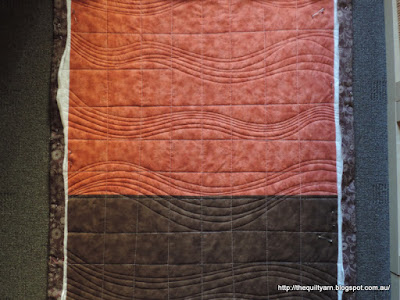My year has been very successful overall. I decided early in the year to participate in the FAL 2016 and that got me going on my outstanding projects. Here is the first finish for the year
Cindy Needham's stencils had arrived over Christmas and I was off playing with them which actually continued for the rest of the year. As many of you would know if you read my blog, I spend about 70% of my time researching, trying new things, playing with gadgets and generally expanding my skill level and knowledge...often with very little to show for it as I get so easily sidetracked 😁
Started on my Wholecloth...and incorporated the stencils into that...this project took about 5 months to complete.
In the meantime I finished a project very close to my heart from 2012, a quilt I used during Leah Day's Freemotion Quilting Wednesday...this is where the obsession started with FMQ. I only had the binding left to complete and while the FMQ is nowhere near the level it is at now, there was something really special about finishing this off. Love this quilt!
The Mandala came next. I completed the Mandala using Cindy Needham's stencils to design and draft the Mandala (this took me ages to do!!!). The Mandala was for a challenge that the SA Quilter's guild had set. It turned out great, except in retrospect I had wished I had used lighter thread to make the stitching more pronounced.
The highlight of the year came next for me. Total surprise....my Wholecloth did win First Place in the Small Quilts category. I was so impressed with this, considering that I completed this Wholecloth as a bit of a practice challenge to myself. While the quilt took many months to complete and looks somewhat crazy in terms of the intensity of the stitching, I must say, this was one of the most relaxing projects I had done in a while.
Recently also completed the quilt below. Not my favourite, but a nice design overall. I used Cindy Needham's Ultimate Shape to complete the quilting and duly got sidetracked into experimenting with those stencils.
Below is my absolute favourite quilt for the year. Designed by Shannon Brinkley and called 'Drifting Leaves'. I had won the fabric and the Aurifil thread...really enjoyed the quilt and the quality of the fabric...a joy to complete. To spice things up a bit I decided to quilt wavy lines allover, something I had wanted to try for a while. This was not FMQ, but done with one of the machine stitches...had a lot of fun doing this and it turned out absolutely great.
Apart from all this, I spent hours designing...
...and recently also worked out how to draw on my Ipad.
As you can see I do jump all over the place...there are just too many things to explore and try out and my passion is FMQ.
Next post will be about my new Ruler foot 😆 It's a wonder I get anything finished actually.
Plans for the new year...hmm...2 Wholecloth quilts! Should be interesting to see what happens with my plans. Maybe my word for the new year should be 'Focus'. Nah...
Wishing all a Very Happy and Creative New Year!
Karin






















































